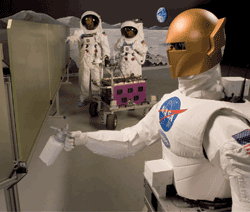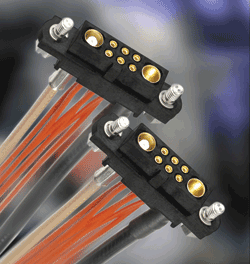A case study of the joint NASA/General Motors humanoid robot and its demand for a hi-rel interconnect system
BY BILL NEUKOMM
Vice President
Harwin
www.harwin.com
Having blasted off into space on February 24 this year, Robonaut 2 — the first humanoid robot destined to become a permanent resident of the International Space Station — is now unpacked and being readied for operation within the ISS’s Destiny Laboratory. However, NASA has much more ambitious plans for Robonaut 2, and future enhancements and modifications will allow it to move more freely around the station’s interior and even outside, working alongside humans or undertaking tasks that are too risky for a human astronaut.

Photo of Robonaut (Photo courtesy of NASA).
Development of Robonaut 2
Robonaut 2’s launch, on board the last flight of the Space Shuttle Discovery, is the fulfillment of a 15-year dream to put a humanoid robot into space. The Robonaut program was conceived to build machines that can help people work in, and explore space, functioning as an assistant to humans, or operating alone in highly hazardous environments.
The requirement for a humanoid robot is much more pragmatic than any sentimental attachment to the human form, or desire for a look-alike, familiar companion/assistant. Simply put, during the course of human space exploration, space flight tools and hardware have been designed to be used by human astronauts. The accumulation of a substantial legacy of in-flight and Extra-Vehicular Activity (EVA) tools necessitates that robots designed to work in partnership with, or as replacements for, humans must be of a humanoid shape — and with an assumed level of human performance.
Therefore, the Robonaut development team adopted the concept of an anthropomorphic robot the size of an astronaut in a space suit, configured with two arms, two five-fingered hands, a head and a torso. Central to Robonaut’s concept is a capability for dexterous manipulation — the ability to use “hands” to do work — and the challenge for the development team was to build machines with dexterity levels, motion, strength and endurance capabilities that exceeds that of a suited astronaut.
Robonaut 2’s hands can interface directly with a wide range of interfaces without “robotic scars,” that is, special grapples and targets, or specialized tools that have previously been required for space robots. Importantly, this design still keeps the human operator in the control loop through its intuitive telepresence control system.
Robonaut 2’s manipulative hands feature an innovative mechatronics design. The arm structure has embedded avionics elements within each link, reducing cabling and EMI noise contamination. Unlike some systems, Robonaut uses a chordate approach to data management, bringing all feedback to a central control system, where even low-level servo control is performed. This biologically inspired neurological approach is extended to left-right computational symmetry, sensor and power duality, and kinematical redundancy, enabling learning and optimization in mechanical, electrical and software forms.
The theory that manufacturing tools caused humans to evolve by requiring skills that could be naturally selected has been applied to Robonaut’s design. Existing EVA tools used by astronauts were the basis for the initial design consideration for the system, hence the development of Robonaut’s dexterous five-fingered hand and human-scale arm that exceeds the range of motion of even unsuited astronauts. Packaging requirements for the entire system were derived from the geometry of EVA access corridors, such as pathways on the Space Station and airlocks built for humans.
Robonaut’s wide range of sensors includes thermal, position, tactile, force, and torque instrumentation, with over 150 sensors per arm. The control system includes an on-board, real-time CPU with miniature data acquisition and power management in a small, environmentally hardened body. Off-board guidance is delivered with human supervision using a telepresence control station with human tracking.
Challenges in design
Robonaut was designed by the Robot Systems Technology Branch at NASA’s Johnson Space Center in partnership with automobile giant, General Motors. NASA and GM have a long, rich history of partnership stretching back to the 1960s with the development of the navigation systems for the Apollo missions and continuing through to the development of the Lunar Rover Vehicle, the first vehicle to be used on the moon.
In many cases, the demands on connectors used in space and the industrial manufacturing environment are similar: they must operate reliably under severe conditions of shock, vibration, and temperature, yet they must also be lightweight, small, and capable of repeated mating and demating. The commercial industrial world adds one further condition: cost.

The “Mix-tek” mixed-technology Datamate connector that is used by NASA on the Robonaut program.
In preparing Robonaut 2 for a life in space, the development team faced several challenges. Nic Radford, Robonaut Deputy Project Manager, comments that although traditional space hardware projects usually take years, “we were given just six months to take Robonaut — a fully developed piece of proprietary hardware—from its lab environment to be qualified for the rigors of space flight. This has involved analyzing the system from a materials point of view, a circuits point of view, and a mechanics point of view.”
Radford continues, “One of the tests we have to perform when getting the robot ready is to simulate in a very real sense the vibration environment of a shuttle flight, by mounting Robonaut in its cargo carrier on a vibration table and shaking it to simulate launch.”
Space applications always call for highly reliable, rugged interconnects in a miniature, lightweight package. With is complex electronics design, Robonaut 2 also requires large amounts of data to be sent from the sensors in the head and hands to the central control system. Another factor affecting connector selection is that Robonaut 2 is modular in construction. Radford states, “We can replace an arm, hand, limb, head … this affords us the opportunity to fly up individual pieces approved for its next stages (of operation), for example a set of EVA arms or an EVA body. The second stage of Robonaut 2’s life on the space station will involve a mobility packagea leg that it can use to move around the space station. We’re going to be upgrading the robot through its life over the next couple of years and were going to get the robot outside.”
Since Robonaut 2 requires several different configurations, the design team needed a versatile, board-to-board connector family that could handle fairly high currents between 10 and 15 A. The team was also under considerable time pressure and needed a solution in a small package. With these considerations in mind, the team chose the mixed-technology “Mix-Tek” version of Harwin’s Datamate I/O connector for this project.
Connectors from this product range have been successfully used in other defense and space projects that are subject to wide extremes of shock, vibration and temperature. The Mix-Tek Datamate connectors are used all over Robonaut, specifically in the head and arms. Another key issue for Robonaut 2 was EMC. Hardware that operates on the ISS (and the Shuttle itself) must not interfere electrically with other systems, nor be susceptible to EMI, so components should be shielded and able to provide electrical screening against RFI and EMI interference.
To view a video of Robonaut and the ISS crew, visit http://bit.ly/jR3Kr ■
Advertisement
Learn more about Harwin USA





